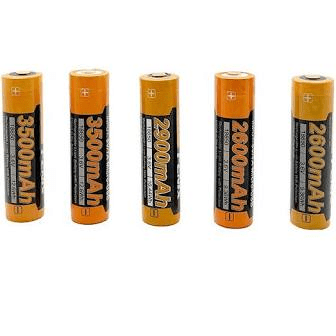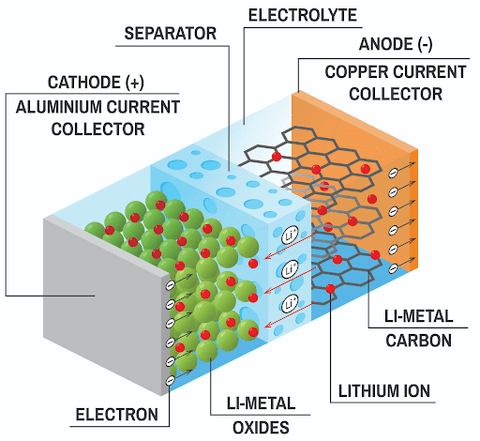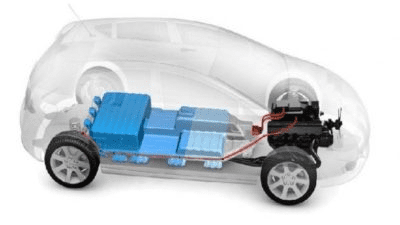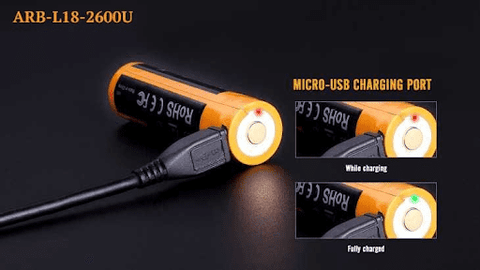We get a lot of questions about the difference between rechargeable batteries and common one-time use batteries like AA & AAA batteries. Between different brands, strengths and confusing names, it can be easy to get lost when trying to research different types of rechargeable batteries and how to best care for them. We put together a complete list of our most frequently asked questions about 18650 batteries to help you understand how to get the very most out of your Fenix light and battery life.
What is an 18650 Battery?
An 18650 battery is a lithium-ion battery. The name derives from the battery’s specific measurements: 18mm x 65mm. For scale, that’s larger than an AA battery. The 18650 battery has a voltage of 3.6v and has between 2600mAh and 3500mAh (mili-amp-hours). (Osborne, 2019) These batteries are used in flashlights, laptops, electronics and even some electric cars because of their reliability, long run-times, and ability to be recharged hundreds of times over. 18650 batteries are what would be considered a “high drain battery.” This means that the battery is designed to generate high output voltage and current to meet the power demands of the portable device in which it is being used. Hence why these powerful little batteries are utilized in more complex, power-hungry electronics that require a constant, high level of power for operation. It also has a high depth of discharge, meaning that the battery can be drained all the way down to 0% and still have the capacity to fully recharge the battery. However, this is not recommended practice, as overtime this will cause long term damage to the battery and affect its overall performance. Learn more about caring for and enhancing the life of your 18650 later in the article.

History of the 18650 Battery
The lithium-ion battery was first invented in the 1970’s by an Exxon researcher named Michael Stanley Whittingham. His pioneering work to create the first version of the lithium ion battery then set in motion decades more research to finetune the battery to be as efficient and safe as possible. Then in 1991, a team of researchers and scientists named John Goodenough, Rachid Yazami, and Akira Yoshino worked together to develop and bring to market the lithium ion cell. The very first lithium ion battery cells were mass produced and sold by Sony. (Neverman et al., 2020) Since then, tweaks and enhancements have been made to extend the output and lifespan of the battery. Each of these changes resulted in a more efficient battery and in turn, a higher demand for their use and applications in the market. Today, lithium-ion batteries dominate the battery industry and have become ubiquitous in many household products we use everyday. There’s a very good chance you own many products powered by 18650 batteries, whether you realize it or not. As of 2011, lithium-ion batteries account for 66% of all portable rechargeable battery sales. (Osborne, 2019)
How a 18650 Battery Works

There are two types of 18650 batteries: protected and unprotected. As a rule of thumb, we always recommend using protected 18650 batteries. 18650 protected batteries have an electric circuit embedded within its packaging. This circuit protects the battery from “over charges” and “over discharges.” Both are situations you want to avoid. When a battery over charges, it can overheat, burst or catch fire.
It doesn’t take much imagination to understand how this malfunction can cause some serious problems for both the user and the manufacturer of the batteries. In fact, In 2016, Samsung released its newest smartphone, the Galaxy Note 7. It didn’t take long for reports to begin coming that the phones were exploding while charging. There had been a flaw in the design of the phone’s lithium ion battery that caused it to short circuit and catch fire.
Two separate recalls were put in place by the The U.S. Consumer Product Safety Commission, covering 1.9 million phones in the United States. Globally, to date, 96 percent of the 3 million phones that were sold have been returned. The debacle cost Samsung a pretty penny and a damaged reputation because of the number of fires and injuries the phones caused. It should be noted that the batteries within these phones were not specifically 18650, they were a larger, different type of 3500mAh lithium ion battery.
But for how widely used these batteries are, it seems like it is one of those easily overlooked technologies that we take for granted. From the moment we wake up to the moment we go to bed, there’s a very good chance we used some kind of 18650 battery. We don’t really realize how much they really do for us throughout our daily lives. Perhaps it’s because lithium-ion batteries are rarely seen on their own, instead they’re always encased inside the object they are charging. Not a lot of people take the time to consider how their electric toothbrush works, let alone how the batteries powering the toothbrush work.
There is actually a lot going on inside the battery’s tiny, colorful packaging. While the battery is being charged, the positive electrode lithium-cobalt oxide gives up some of it’s lithium ions which travel through the electrolyte to the negatively charged graphite electrode on the opposite side of the battery. The ions remain there until the battery is in use, during which the lithium ions travel back to the positive electrode, producing energy and powering the battery as it does so. In both the charging and discharging instances, electrons are flowing in the opposite direction of the ions around the outer circuit of the battery. (Osborne, 2019) The flow of ions through the electrolyte and electrons through the outer circuit are an interconnected process. One does not and can not happen without the other. Thus, should the battery completely discharge and the ions stop moving through the electrolyte, the electrons can’t make their way through the outer circuit and power is lost.
In the same way, should you turn off the object your battery is powering, the electrons will stop flowing through the circuit and so too will the ions. In essence, the battery stops discharging at a high rate. It should be noted that the battery will still continue to discharge at a very slow rate, regardless of whether the appliance is connected. Hence why you should always check the power level of your batteries every month or two in appliances that get more infrequent use.
What makes lithium-ions different from more simplistic batteries is their electronic controllers. These can be found only in the aforementioned “protected” batteries. Electronic controllers are built-in systems that regulate how the battery charges and discharges. It’s meant to prevent any overcharging or overheating that can, in some cases like the Galaxy Note 7 incident, cause lithium-ion batteries to explode. Using an unprotected lithium-ion battery can be tricky business to the uninitiated battery user. They are designed much more simply, meaning there is less of a chance for something to malfunction and are a bit smaller than protected batteries so they can fit into tighter spaces. However, the lack of protection opens the door to higher risks of overheating and explosion. Using unprotected batteries will, in general, yield the same performance but require more vigilance when it comes to charging and discharging.
Average Cost of a 18650 Battery
The cost of a 18650 battery can range widely depending on the brand, package size and whether it is a protected or unprotected battery. For example, the Fenix 18650 battery can range in price from $9.95 to $22.95 (these batteries are cheaper than most other brands when factoring in discounts), depending on the particular battery variation you are interested in. These batteries have a USB charging port right on the side of the battery itself, making recharging simple. They are at a bit higher price point than others because they are built with safety as a top priority, boasting three sets of overheating protection to prevent short circuiting so you can get up to 500 charge cycles out of a single battery without cause to worry about explosion or over discharging. Some unprotected batteries on the market can be found at cheaper prices, but as with anything you buy online, it’s important to factor in more to your purchase decision than just the price.
Pro Tip: As a general rule, if it seems too good to be true, it probably is. We suggest always buying any kind of technology, especially potentially dangerous ones like lithium-ion batteries, from a trusted source or name brand manufacturer.
Buying improperly manufactured or poorly made chemically-based products can yield unpleasant results, causing injury and destroying the appliance you were meaning to power. Before purchasing batteries online, it might be a good idea to check reviews from past customers or online tech forums to make sure you’re making a safe choice that also fits your power needs.
Different Types & Uses of 18650 Batteries

There are as many brands of 18650 batteries as there are uses. 18650 batteries are some of the most versatile on the market. They can be used to power just about anything, from electric cars to digital cameras.
As stated before, it is important to do your research beforehand when it comes to purchasing such potentially dangerous, though extremely useful products. Electric cars, such as the Tesla Model X and Model S , is what is known as a BEV, aka: battery electric vehicle.
These cars are powered by a hoard of lithium ion cells all working together. The Model S is powered by a battery pack that contains over 7,104 18650 cells capable of storing up to 85 kWh of energy. Recently, Tesla engineers have redesigned a new battery pack for their electric cars to hold 516 cells in each module for a total of 8,256 cells capable of storing a little more than 100 kWh of energy. This makes it possible for these electric cars to have a max range of over 300 miles on a single charge. It is a marvel to see how far scientists and engineers have come to in such a relatively short time. Everyday new improvements and enhancements are pushing the bounds of what this technology can do, how we think about electricity, and what role it will play in our everyday lives in the future.
How to Charge 18650 Battery

Depending on the brand of 18650 battery, you might need to charge your batteries as they were designed. But, for the most part, you don’t really need a specific type of charger or special cord to recharge your batteries – as long as it’s rated safe to charge lithium ion batteries. If you use a charger that is not meant for lithium ion battery types, it could result in, at best, permanent damage to your batteries and at worst, they could explode. Some batteries, such as the Fenix 18650 battery detailed above, actually are charged directly using simply a USB cord.
To get the very most out of your battery’s life span, we suggest making sure that your batteries are never fully discharged or drop too low in power if you can help it. Totally discharging the battery makes the ion transfer process much harder when it comes time to recharge the battery, thus limiting the capacity of the battery as a whole. The same is true for overcharging your batteries. Intaking too much power at once can put stress on the cells and cause damage in the long run. Instead, experts suggest “partial” charges to extend the overall lifespan of your batteries. While this does mean you might have to charge your batteries more often, it will save you time and money in the long run by helping you get the very most out of your existing batteries, saving you from the need to buy more.
How Long Do 18650 Batteries Last?
Most 18650 batteries have a life cycle of around 300-500 charge cycles. For example, Fenix batteries are rated for 500 cycles. This means that the battery will be able to fully charge to at least 80% of its initial capacity. Once it reaches that threshold, the battery’s “life cycle” is considered over. Though you can still probably get plenty more charges out of the battery, it’s capacity will slowly diminish further with time.
Most of us have all experienced this first hand when buying a new smartphone. Time and use will slowly diminish the battery’s life capacity, even with careful charging considerations. Extreme hot or cold temperatures can affect your battery life, as well.
Pro Tip: Make sure to never charge your 18650 batteries in below freezing temperatures! This can cause significant degradation and damage. For example, don’t leave your batteries to charge in a freezing garage in the winter.
How Long Does It Take to Charge a 18650 Battery?
The average 18650 battery takes about 4 hours total to charge. Of course, this can vary a bit based on the health of your battery and the type of charger you are using. To check the health of your 18650 battery, try to take note of how long it takes the battery to charge up, whether it is accumulating more heat than usual while it charges, if it is not producing as much power as it once did, or holding a charge as well. These are all indicators that your battery is reaching its end of life.
18650 Battery Storage Best Practices
18650 batteries need to be stored in a dry, room temperature space. Avoid any situations that might subject your batteries to either extreme cold or heat. Between the range of -20 to +50°C (-4°F to + 122°F) is sufficient but the most optimal storage temperature is somewhere around 77°F or 25°C. If you are planning on storing your batteries over a long period of time, it is actually better to have them charged at around 50% rather than 100%. This will help extend the lifespan of your batteries over time. Make sure to remove the batteries from it’s application before long term storage. For example, if you use your rechargeable batteries in a flashlight, take them out to be stored separately.
Pro Tip: Never store batteries in a pocket or bag that also includes any metal items such as keys, pins, or coins. This might cause accidental discharge. (battery & Instructables, 2017)
How to Discard Batteries Safely
Once your 18650 battery has reached the end of its life span, it is important to dispose of them responsibly. Never simply through these batteries into the trash! Though lithium ion batteries do not contain as many of the dangerous chemicals as other batteries, they still are considered hazardous waste and can cause fires or leak harmful chemicals into the earth. Many electronic or home improvement stores will have battery drop off zones or hazardous waste collection bins where you can get rid of your dead batteries without potentially causing environmental damage. Stores or collection centers will then send these batteries to recycling centers where they can harvest the metals inside to be reused. This is the most environmentally-friendly and economical way to dispose of old, damaged, or leaking batteries.
Rechargeable Batteries, Accessories and Flashlights
If you are in the market for a new rechargeable battery, flashlight or accessory. Fenix Lighting has been a trusted leader in rechargeable lighting solutions for decades. We offer state-of-the-art lithium-ion battery technology. Our rechargeable batteries and lighting solutions provide some of the very best in efficiency, performance, and lifespan in the industry. With thousands of satisfied customers and counting, our customers and fans come back to us again and again because they know when they buy Fenix, they are getting reliable, quality products backed by a full guarantee. Give our lineup a look or feel free to contact our friendly customer service line for recommendations or advice.
Source Cited:
Osborne, O. (2019, September 09). Where did the Lithium Ion battery come from? – 18650UK. Retrieved January 25, 2021, from https://18650.uk/where-did-the-lithium-ion-battery-come-from/
Neverman, A., Says, G., Grammyprepper, Says, A., Says, D., Smith, D., . . . Alonso, R. (2020, October 28). Everything You Need to Know About the 18650 Battery. Retrieved January 25, 2021, from https://commonsensehome.com/18650-battery/#:~:text=18650%20protected%20batteries%20have%20an,over%20current%20and%20short%20circuit
Understanding Tesla’s lithium ion batteries. (n.d.). Retrieved January 25, 2021, from https://evannex.com/blogs/news/understanding-teslas-lithium-ion-batteries
Battery, 1., & Instructables. (2017, September 29). How to Prolong the Life of an 18650 Battery. Retrieved January 25, 2021, from https://www.instructables.com/How-to-Prolong-the-Life-of-an-18650-Battery/


